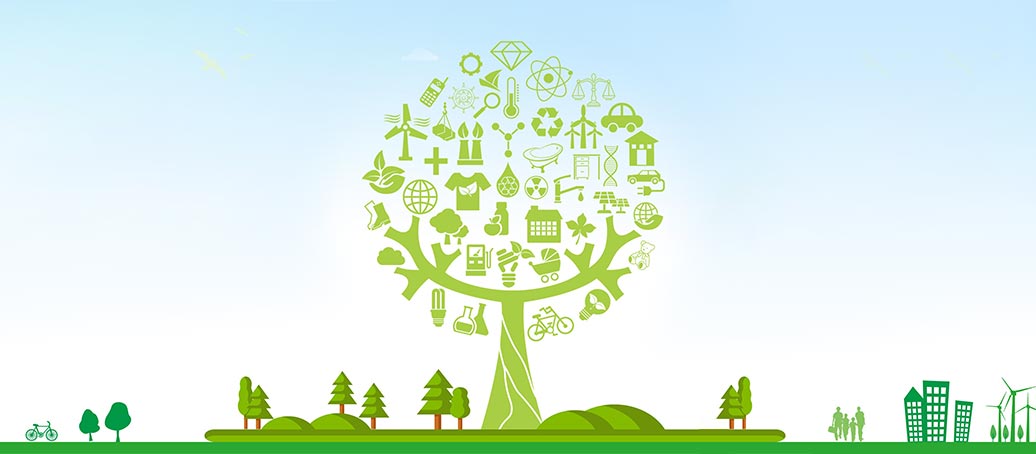1. Climate Change Governance
We identify and disclose the Company's policies and actions in addressing climate risks and seizing climate opportunities by establishing a climate change governance structure. The Board of Directors is responsible for monitoring the risks and opportunities related to climate change, and reviewing environmental, social, and governance reports annually, including the topic of "addressing climate change". The ESG Management Team is established under the Company's Strategy and Merger and Acquisition Committee, which is responsible for coordinating and managing ESG related matters, including climate change, and regularly reporting to the Chairman.
2. Strategy and Risk Management
We have been paying long-term attention to climate change and actively responding to the "dual carbon" goal. During the reporting period, we were approved as a verification institution of the Gulf Cooperation Council, becoming the only institution in China that has obtained the qualification of the Global Carbon Committee, providing convenience for the owners of greenhouse gas emission reduction projects. We refer to the analytical framework on climate related risks and opportunities proposed by the
Taskforce on Climate-related Financial Disclosures (TCFD), and the ESG working group will identify and evaluate the Group's climate change related risks and opportunities, providing a basis for further controlling climate related risks and seizing climate related opportunities.
In line with TCFD's recommendations, we identified potential physical and transformational risks. At the same time, we identified opportunities in the context of the "dual carbon" scenario.
|
Risk type |
Climate risk factor |
Risk classification |
Description |
Involved business section |
Impact intensity |
|
Physical risks |
Extreme climate disasters |
Acute operational risks |
Extreme climate disasters will cause physical damage to the physical assets of the affected areas. CTI Group has many offices and laboratories located in coastal areas and areas with rich rainfall which further increases the impact of extreme weather on the Group’s operations. |
CTI group-wide |
High |
|
Climate Change |
Chronic Operational Risk |
If CTI's customers from the fields of agriculture, forestry, fishery, animal husbandry and other industries encounter long-term global warming, sea level rise and other climate changes. Their normal production and operations may be affected as resulting in the loss of CTI's specific business. |
CTI group-wide |
Low |
|
|
Transition Risk |
New policies for low-carbon Economic transition |
Market and technology risks |
China has committed to the 3060 dual carbon targets; the government has introduced new policies to support low-carbon transformation. The Group has made efforts to reduce the impact of its operations on the natural environment. We have carried out measures to reduce energy consumption and greenhouse gas emissions. |
CTI group-wide |
High |
|
Energy transition policies |
Market and technology risks |
Due to the government's more stringent emission reduction policies, the company needs green energy with lower emissions to replace the existing high-emission energy sources, which increases the cost of transitioning to lower-emission technologies. |
CTI group-wide |
Middle |
|
|
Carbon market price fluctuations |
Market and Reputation risks |
As the government has introduced more stringent carbon emission policies, the company's cash flow will be affected by carbon market price fluctuations. But the Group is not a high-emitting enterprise, and then the fluctuated carbon market price is low risk to the Group. |
CTI group-wide |
Low |
|
|
Regulatory Mandatory Information Disclosure |
Operational and Reputation Risk |
Regulatory and mandatory disclosure of climate-related financial information, lacking of historical data and accurate accounting methods, it affects the quality of disclosure. |
CTI group-wide |
Low |
|
|
Raising environmental protection standards |
Market and technical risks |
As the government has introduced more stringent environmental protection policies, the company needs to raise building energy consumption standards to comply with laws and regulations for energy conservation and low emission standards. It may increase R&D investment for energy conservation and environmental protection measures. |
CTI group-wide |
High |
|
Opportunities |
Our climate-related opportunities are primarily in services and markets. China's "3060" carbon neutrality goal has been upgraded to a national strategy. More and more companies (organizations) have begun to transit to a low-carbon green economy. Therefore, we can give full effort to our service advantages in energy management, energy conservation and emission reduction, green environmental protection, etc. We help partners transforming to a low-carbon, circular, and green economy, and hence to build a green financial system. Our country has formulated policies for low-carbon products and services for many industries which has further expanded the market demand for low-carbon, green technologies and services. |
3. Metrics and Targets
The company manages greenhouse gas emissions generated by company operations such as laboratory and office electricity consumption, heating, cooling, and business travel through monthly reports and online system filling, and integrates and analyzes these emissions.
In 2022, our total carbon emissions at the operational level were 121,658.2 tonnes of carbon dioxide equivalent, including 2,672.5 tonnes of carbon dioxide equivalent emissions from Scope 1, 73,954.5 tonnes of carbon dioxide equivalent emissions from Scope 2, and 45,031.2 tonnes of carbon dioxide equivalent emissionsed from Scope 3, as shown in the following table:
|
No. |
Scope |
Type |
Main Content |
Carbon Emissions (tonnes of CO2 eqv) |
Percentage |
|
1 |
One |
Natural gas |
Natural gas is mainly used for heating, humidification and laboratory sterilization in Suzhou biological animal laboratory |
731.0 |
0.6% |
|
2 |
One |
Gasoline |
Daily consumption as the power source of CTI's own sampling vehicles, mobile monitoring vehicles, fast inspection vehicles, medical examination vehicles and commercial vehicles |
399.1 |
0.3% |
|
3 |
One |
Diesel |
Consumption as a power source for generators and self-owned sampling vehicles |
171.6 |
0.1% |
|
4 |
One |
Refrigerant |
Emissions from Refrigeration Equipment (Air Conditioning) in CTI Office |
731.1 |
0.6% |
|
5 |
One |
Septic tank |
Discharges from CTI's own base sewage treatment |
639.7 |
0.5% |
|
Total of Scope One |
2,672.5 |
2.2% |
|||
|
6 |
Two |
Purchased electricity |
Power consumption of CTI's own and leased offices and laboratories |
71,245.9 |
58.6% |
|
7 |
Two |
Purchased heat |
The purchased heat for central heating of CTI's own and leased offices |
2,708.6 |
2.2% |
|
Total of Scope Two |
73,954.5 |
60.8% |
|||
|
8 |
Three |
Business travel |
Carbon emissions from employee travel (cars, high-speed trains, airplanes, etc.) |
45,031.2 |
37.0% |
|
Total of Scope Three |
45,031.2 |
37.0% |
|||
Note:
1. In 2022, the data coverage of Scope 1 and Scope 2 includes the group headquarters and all subordinate institutions and offices within and outside China, while Scope 3 covers the group headquarters and all subordinate institutions and offices within China.
2. The emission factors are selected from the 2022 national grid average emission factor (0.5703 tCO₂/MWh) released by the Ministry of Ecology and Environment, the world's most authoritative Ecoevent 3.7 database based on life cycle analysis applicable to China's region or the world, international authoritative emission factors such as GHG Protocol and UK Defra, or relevant authoritative official documents issued by domestic governments.
3. Considering the technical feasibility and cost feasibility comprehensively, the other indirect emissions mainly considered are the carbon emissions generated by employees taking transportation vehicles (cars, high-speed railways, airplanes, etc.) during their official business trips.
4. Dealing with Climate Change
By identifying, assessing, and analyzing the potential financial impact of climate risks and opportunities on the Company's business and operations, we currently mainly adopt three strategies to address climate change: green office, green travel, and green services.
- Green Office
We adopt the classified energy management approach. For electricity consumption management, we encourage efficient use of electricity in laboratories and offices, strengthen the management of electricity consuming equipment, efficiently utilize experimental equipment, and reduce electricity consumption; promote the use of energy-saving electrical appliances, advocate turning off the lights at will, and reduce the standby energy consumption of office equipment. For gasoline usage management, the Company adopts registration of fuel cards, driving mileage, and other methods for reasonable control, and gradually uses electric sampling vehicles to replace gasoline and diesel sampling vehicles.
- Green Travel
In order to reduce the distance of business travel, we prioritize assigning the employees close to the project site as team members according to the business needs. We use the video conference room to reasonably reduce the number of business trips. At the same time, we encourage employees to give priority to green travel vehicles, such as public transportation and bicycles.
- Green Services
We continue to improve our climate-related services, strengthen our attention and research on climate change and related regulations and policy trends, and constantly improve the quality and forward-looking of sustainable development services such as climate change from the perspective of customer needs.










































 粤公网安备 44030602000441号
粤公网安备 44030602000441号